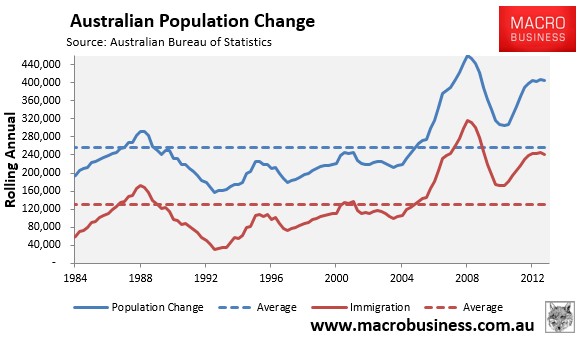
The OECD has released a new report entitled “Is Immigration good for the economy?”, which attempts to counter what it calls “ill-informed perceptions, which, in turn, can lead to public antagonism towards migration”.
The report delivers a fairly lukewarm assessment about immigration’s benefits to economies, claiming that it is neither a “panacea” for boosting growth or improving improving public finances:
The study suggests the impact of the cumulative waves of migration that arrived over the past 50 years in OECD countries is on average close to zero, rarely exceeding 0.5% of GDP in either positive or negative terms…
Immigrants are thus neither a burden to the public purse nor are they a panacea for addressing fiscal challenges…
International migration has both direct and indirect effects on economic growth. There is little doubt that where migration expands the workforce, aggregate GDP can be expected to grow. However, the situation is less clear when it comes to per capita GDP growth.
… migrants arrive with skills and abilities, and so supplement the stock of human capital of the host country…
Few empirical studies have tried, however, to estimate the overall impact of net migration on economic growth, in part because of a shortage of harmonised comparative data on international migration by skills levels.
One study that looks at the impact of migration on economic growth for 22 OECD countries between 1986 and 2006 demonstrates a positive but fairly small impact of the human capital brought by migrants on economic growth. The contribution of immigrants to human capital accumulation tends to counteract the mechanical dilution effect (i.e. the impact of population increase on capital per worker), but the net effect is fairly small, including in countries which have highly selective migration policies. An increase of 50% in net migration of the foreign-born generates less than one tenth of a percentage-point variation in productivity growth.
As noted by the UK Telegraph, this is one of those studies that could be seized by either side of the immigration debate. Opponents to immigration could use it to undermine claims that immigration is required to boost public finances as the baby boomers retire, whereas proponents could point to the positive (albeit tiny) purported economic benefits.
The OECD findings also accord with modelling from Australia’s Productivity Commission, which found that immigration is neither beneficial (or necessarily detrimental) for the economy or living standards, nor can it alleviate the impacts of an ageing population.
My own view with regards to Australia is that immigration is not an all or nothing proposition. A moderate migration program – commensurate to what existed prior to the start of the Howard Government’s mid-2000s population ponzi – is fine (see next chart), but the current immigration intake is far too large, and is placing too much strain on Australia’s infrastructure and housing.

As explained recently by Dr Katherine Betts from the Monash University Centre for Population and Urban Research, when immigration is too high, it can drain the nation’s productivity by crowding-out productive investment and capital deepening:
The Productivity Commission report on ageing points out that the infrastructure spending needed to manage population growth over the next 50 years will be five times the total that was needed over the last 50 years. This investment in capital widening must seriously weaken Australia’s capacity to invest in the capital deepening that would boost productivity…
Population growth imposes pressures on infrastructure and adds to congestion; in so doing it depresses productivity.
International comparisons show that there is no association between population growth and growth in per capita GDP. This is not surprising as comparative data on 32 OECD countries show no positive association between population growth and growth in labour productivity…
Assertions that immigration-fuelled population growth will boost productivity remain conjectural. There is no empirical evidence that such growth in an advanced economy increases productivity.
In Australia’s case, there is also the concern that we earn our way in the world mainly by selling our fixed mineral resources (e.g. iron ore, coal, natural gas, and gold). And more people means less resources per capita. It also means that we must deplete our mineral resources faster just to maintain a constant standard of living.
High immigration and population growth is fine if it is for a purpose and fits an overall plan. But instead, Australia’s governments have pursued an uncoordinated approach, growing for growth’s sake and pushing the nation up against infrastructure bottlenecks. It has also diluted our fixed endowment of minerals resources, potentially lowering the living standards of the existing population.

